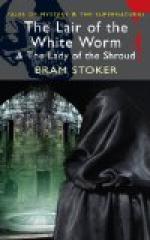Sir Nathaniel thought for a while before he answered.
“We must be careful not to confuse the physical and the moral. I can see that already you have switched on the moral entirely, so perhaps we had better follow it up first. On the side of the moral, we have certain justification for belief in the utterances of revealed religion. For instance, ‘the effectual fervent prayer of a righteous man availeth much’ is altogether for good. We have nothing of a similar kind on the side of evil. But if we accept this dictum we need have no more fear of ‘mysteries’: these become thenceforth merely obstacles.”
Adam suddenly changed to another phase of the subject.
“And now, sir, may I turn for a few minutes to purely practical things, or rather to matters of historical fact?”
Sir Nathaniel bowed acquiescence.
“We have already spoken of the history, so far as it is known, of some of the places round us—’Castra Regis,’ ‘Diana’s Grove,’ and ’The Lair of the White Worm.’ I would like to ask if there is anything not necessarily of evil import about any of the places?”
“Which?” asked Sir Nathaniel shrewdly.
“Well, for instance, this house and Mercy Farm?”
“Here we turn,” said Sir Nathaniel, “to the other side, the light side of things. Let us take Mercy Farm first. When Augustine was sent by Pope Gregory to Christianise England, in the time of the Romans, he was received and protected by Ethelbert, King of Kent, whose wife, daughter of Charibert, King of Paris, was a Christian, and did much for Augustine. She founded a nunnery in memory of Columba, which was named Sedes misericordioe, the House of Mercy, and, as the region was Mercian, the two names became involved. As Columba is the Latin for dove, the dove became a sort of signification of the nunnery. She seized on the idea and made the newly-founded nunnery a house of doves. Someone sent her a freshly-discovered dove, a sort of carrier, but which had in the white feathers of its head and neck the form of a religious cowl. The nunnery flourished for more than a century, when, in the time of Penda, who was the reactionary of heathendom, it fell into decay. In the meantime the doves, protected by religious feeling, had increased mightily, and were known in all Catholic communities. When King Offa ruled in Mercia, about a hundred and fifty years later, he restored Christianity, and under its protection the nunnery of St. Columba was restored and its doves flourished again. In process of time this religious house again fell into desuetude; but before it disappeared it had achieved a great name for good works, and in especial for the piety of its members. If deeds and prayers and hopes and earnest thinking leave anywhere any moral effect, Mercy Farm and all around it have almost the right to be considered holy ground.”
“Thank you, sir,” said Adam earnestly, and was silent. Sir Nathaniel understood.




